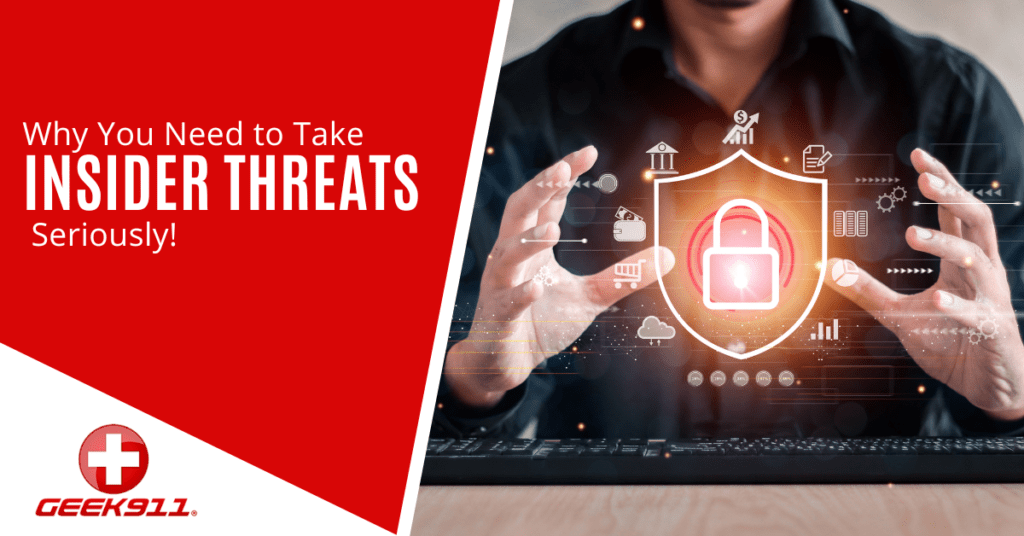Why You Need to Take Insider Threats Seriously!

Insider threats are becoming a rising concern in a variety of businesses. Every year, insider risks harm more than 34% of firms worldwide. Most focus is on external attacks, huge corporations, and government institutions. On the other hand, internal security is something that companies must take very seriously to avoid irreversible damage.
However, corporations frequently fail to protect themselves against their personnel’s threats, referred to as insider threats.
An insider threat is any employee, vendor, contractor, or anybody within a company who has authorized access to sensitive data or IT systems and uses that access in a way that harms the company.
Many businesses cannot afford internal threat detection programs. They can, however, take proactive precautions to avoid them, particularly when it comes to critical systems and data. And this is not limited to network security firms or government organizations; any business might be the victim of an insider attack or leak.
Insider Threat Type
Insider Misconduct
Negligent insiders, like accidental insiders, do not actively hurt the business but do so through negligence or carelessness. This could be accomplished through shadow IT or by delaying updates or security fixes, which could result in a cyberattack.
Unintentional Insider
As with accidental insiders, not all insider threats have malicious intent. Individuals who unwittingly enhance cyber risk or hurt the firm are unintentional insiders.
Cruel Insider
Cruel insiders are people who deliberately abuse their access to data or IT systems for personal or financial advantage. Cruel insiders can also be ex-employees who have continued access to information and IT systems or have exfiltrated material before leaving.
Insider Threat Prevention Measures
It only takes one error or one dishonest employee to bring your company’s entire security infrastructure down. Regarding security, internal dangers should be treated equally as seriously as external threats. The following strategies can assist any firm in taking a proactive approach to internal security without expensive security program spending.
Make use of Strong Password Authentication.
Companies frequently fail to implement even the most basic security precautions, such as password authentication and the use of strong passwords. Furthermore, in many firms, passwords are shared by multiple employees. These lax practices expose critical network systems to internal and external attackers.
Using multi-factor authentication, at least for the most critical portions of the IT ecosystem within the firm, is one of the most convenient yet effective approaches to ensure robust password security. Multi-factor authentication should protect data storage, accounts, and financial systems.
Safeguard Physical Servers
If you have physical servers on-site, physical security must be implemented for those servers. These servers should be kept securely and discreet on the enterprise’s premises. This information must not be made public or distributed throughout the organization.
At all times, a security guard should be present. Furthermore, digital security solutions should guard access to server rooms. Again, multi-factor authentication is advised. Only authorized individuals should have access, and their access and usage should be tracked using cameras and access information. Furthermore, physical security assessments should be undertaken regularly to verify that servers and other physical tech infrastructure are adequately secured.
Awareness of Security and Insider Threats
Internal breaches might occur as a result of the smallest of errors. As a result, internal security communication and awareness are critical. Internal security should be a major component of your organizational security policy, with suitable mechanisms for workers and contractors to follow to guarantee that destructive forces within the organization do not misuse access.
Employees are prone to laziness regarding topics they are unfamiliar with. It would help if you underlined the importance of dealing with internal dangers. This information can be incorporated into new employee training while existing staff should receive a refresher every year.
Control of Access
The number of people who control or have access to the most sensitive data should be kept to a minimum. That does not mean that only one person should access all of the system’s sensitive components. On the other hand, strong access control entails only granting access to the most trustworthy individuals in your company network.
Access should also be verifiable to see who accessed what information or software and when. This is in connection with monitoring, as monitoring software can utilize this information to analyze security risks.
Tools for Monitoring User Activity
The easiest way to detect insider threats is to employ monitoring technologies that continuously monitor user activity for malicious access or unusual behavior. It can also make it easy to examine such a threat or action further, assisting in identifying the true perpetrator.
Using security technologies or Change Tracking can aid in the detection of unusual patterns in user activity. Similarly, audits and compliance security capabilities allow teams and managers to strengthen security further.
Need Help Heading Off Insider Threats?
Many companies fail to implement the required procedures to detect and defend against insider threats.
Contact us immediately at GEEK911 if your company wants to start addressing internal threats seriously. We can assist with the adoption of security solutions and cybersecurity awareness training. Call (866) 433-5411.
